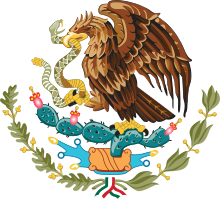 Global Information
Global InformationHistory of Mexico City information

The history of Mexico City stretches back to its founding ca. 1325 CE as the Mexica city-state of Tenochtitlan, which evolved into the senior partner of the Aztec Triple Alliance that dominated central Mexico immediately prior to the Spanish conquest of 1519–1521. At its height, Tenochtitlan had enormous temples and palaces, a huge ceremonial center, and residences of political, religious, military, and merchants. Its population was estimated at least 100,000 and perhaps as high as 200,000 in 1519 when the Spaniards first saw it.[1] During the final stage of the Spanish conquest of the Aztec Empire, Spanish forces and their indigenous allies besieged and razed Tenochtitlan. Because it was strategically and politically important, invader Hernán Cortés founded the Spanish colonial capital of Mexico City on its ruins, becoming the center of Spanish colonial power. Following Mexican independence from Spain in 1821, Mexico City became the capital of the sovereign nation, remaining its largest and most important city to the present day.

Beginning in 1521, the Aztec ceremonial and political center was rebuilt as the city's main square, the Plaza Mayor, usually called the Zócalo. Some of the oldest structures in Mexico City date from the early conquest era. Many colonial-era buildings remain standing and have been re-purposed as government buildings and museums. As the seats of the Viceroyalty of New Spain and the Archbishopric of New Spain, Mexico City was the center not only of political and religious institutions but also of Mexico's economic activity and the residence of Spanish colonial elites (1521–1821). Great merchant houses linked to Spain were located here, and the economic elites whose properties were often elsewhere in New Spain also lived in the capital. The concentration of mansions and palaces in what is now the Mexico City historic center led it to be nicknamed the "City of Palaces",[2][3] a sobriquet often attributed, perhaps erroneously, to great savant Alexander von Humboldt. It was also a major educational center: the University of Mexico was founded in 1553 as part of the complex of the Plaza Mayor but is now located in the south of the capital. Many religious institutions for the education of the sons of Spanish elites were also based in the capital. Mexico City had the colony's largest concentration of those of Spanish heritage (both Iberian-born peninsulares and American-born criollos), as well as the largest concentration of mixed race casta population in the colony. Many indigenous people also lived in the capital, outside the central core, concentrated in their own section and governed by an indigenous town council. Post-independence, U.S. forces captured Mexico City during the Mexican–American War,[4] and the city saw violence during the Reform War and the French Intervention as well as the Mexican Revolution.[3] At the beginning of the 20th century, the city's population stood at about 500,000.[5] The city's history in the 20th and 21st centuries has been marked by explosive population growth and its accompanying problems.[3] The city center deteriorated.[6] The government has had problems keeping up with basic services, but the building of the Mexico City Metro has alleviated some major transportation problems. Smog became a serious problem as the shanty towns evolved, formed by the poor of the country migrating to the city. The 1985 Mexico City earthquake caused significant damage to the center of the city. In the 2000s, businessman and philanthropist Carlos Slim created a foundation to revitalize the historic center as well as sites near the Basilica of the Virgin of Guadalupe. In 2016, the Mexican government initiated the process of greater autonomy from the federal government, creating the Ciudad de México or CDMX.[7]
- ^ Frances F. Berdan, The Aztecs of Central Mexico: An Imperial Society, New York: Holt, Rinehart, and Winston 1982, p. 14.
- ^ Cite error: The named reference
Marroquiwas invoked but never defined (see the help page). - ^ a b c Alvarez, José Rogelio (2000). "Mexico, Ciudad de". Enciclopedia de Mexico (in Spanish). Vol. 9. pp. 5242–5260.
- ^ "The Storming of Chapultepec (General Pillow's Attack)". PBS. Retrieved 18 October 2008.
- ^ LaRosa, Michael J., ed. (2005). Atlas and Survey of Latin American History. Armonk, New York City: M. E. Sharpe, Inc. pp. 118–125.
- ^ Noble, John (2000). Lonely Planet Mexico City:Your map to the megalopolis. Oakland CA: Lonely Planet. ISBN 978-1864500875.
- ^ [1] "From DF to CDMX, Mexico City changes name and status" accessed 31-1-2023